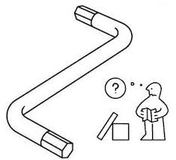weekly column
|
Each week, find a commentary on something connected to verses of Torah or another source of wisdom
|
|
Each week, find a commentary on something connected to verses of Torah or another source of wisdom
|
 The Exodus:5 Project He cast four rings, at the four corners of the copper grating, as holders for the poles. Exodus 38:5 Among the great delights of my free time is the opportunity to put something together. Over many years and many visits to Ikea and other assemble-it-yourself purveyors I have discovered deep satisfaction in laying out a seemingly random assortment of parts both large and small and putting them together with screwdrivers, pliers, hammers and impossibly small Allen wrenches. The biggest problem I have with such projects is resisting the impulse I share with lots of men I know. I would rather eyeball everything and try to figure out how it all goes together than read the actual directions. If you are someone who struggles with this affliction, please learn from my experience. Read the actual directions. Some manufacturers include extra material in the kits they sell. I have many odd-sized nuts, bolts, screws and braces (and a generous handful of tiny brads) left over from my assembly projects. I save them all because…you never know. In forty-plus years of salvaging serrated wood plugs and proprietary locknuts, I am grateful that once or twice my hoarding has been vindicated. But every now and then, I finish a project (like the barbecue grill I built in time for Passover one year) and there remains a piece too large and distinctive to be a just-in-case addition from the company. Maybe you know the feeling when you reach the next-to-last step and a large piece of metal or a brass hinge or a tightly coiled spring is looking at you accusingly, silently taunting you about the imminent collapse of that wardrobe or about the lid that will slam shut on your fingers or head. Nothing in these kits is incidental, including the occasional spare peg or wood screw. In order for the finished product to function as intended (and maybe at all) everything must be in its place. The Ark of the Covenant was outfitted with rings, two on each long side near the corner, into which the crafted poles were to be inserted. Designated Levites could then lift the ark like a bride hoisted at a wedding feast in order to carry it to its next destination. Without every ring fastened securely and identically in the specified place, the ark could fall – a calamity, according to the tradition – or a fast-thinking Levite would reach out to steady it – a scenario played out to fatal results in the time of King David. I have some understanding, I think, of the haphazard way our government seems to be lurching among policies these days. The people in charge, who are enthusiastic but inexperienced, see the pieces laid out in front of them and hold a picture of the finished product in their minds. But they are loathe to follow any established protocol. There are too many extra pieces, they believe, and they trust their instincts to compensate for their novice status. Why do we need so many foreign service members? Why can’t we combine entire departments with similar missions (like Labor and Education – after all, all they do is train people to work [I am not making this up])? And if we know the outcome of an immigration hearing before it begins, why go through the motions at all? Instead of using those cumbersome and uncomfortable little wrenches, a hammer and some leftover nails will secure the pieces together. If it was someone’s ingenuity that put the thing together to begin with, let’s use the ingenuity that made America great before to make America great again. After all, we know what we want, don’t we? You may think I am lampooning the way pieces of government (and culture) are being discarded or placed in the drawer with the leftover locknuts. I am not. I may be critical of the way things are, and I may sprain my eyes from rolling them so frequently at the lack of both procedural and Constitutional literacy, but I take these times in with deadly seriousness. Not every civil servant or policy may be singularly necessary to a functional government, but you don’t want to be looking at something you thought wasn’t necessary after you discover that without it you are left with a cageful of motherless children. Pay attention, please. You won’t balance a television on a cabinet that was built sort-of to spec, and you shouldn’t balance a budget with a cabinet that was chosen sort-of to spec. Every piece is there for a reason. Every department. Every policy. Every civil servant. Every political appointee. Oh, and every vote.
0 Comments
Leave a Reply. |
Archives
October 2023
Categories |